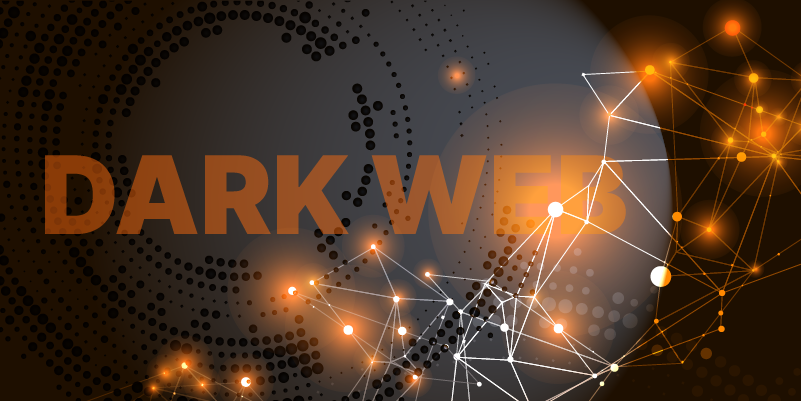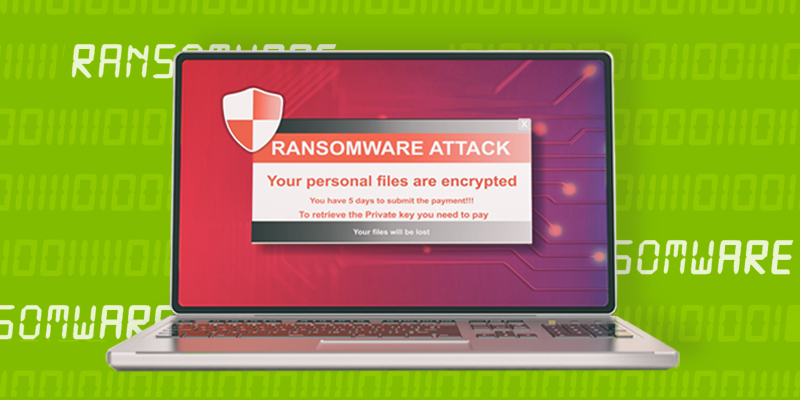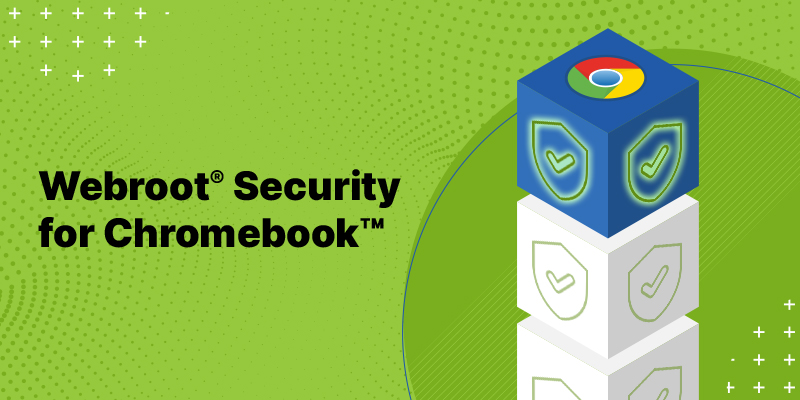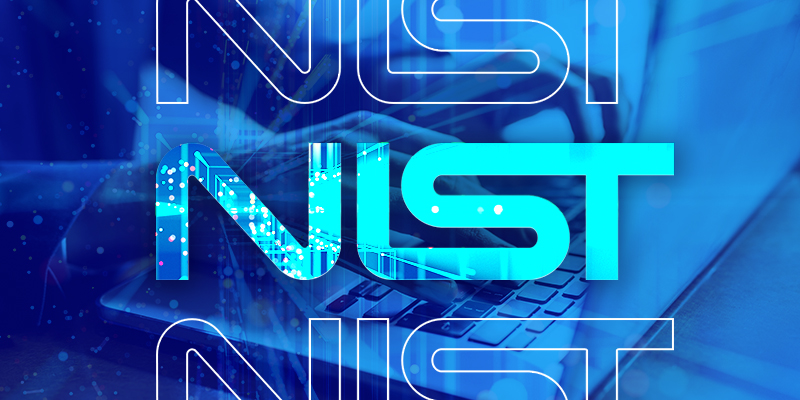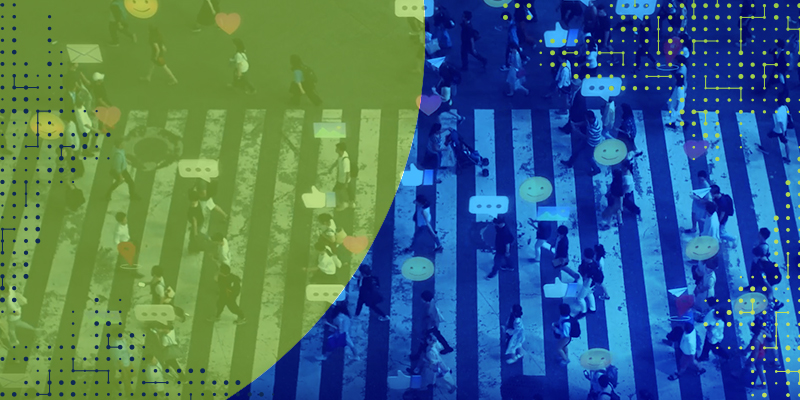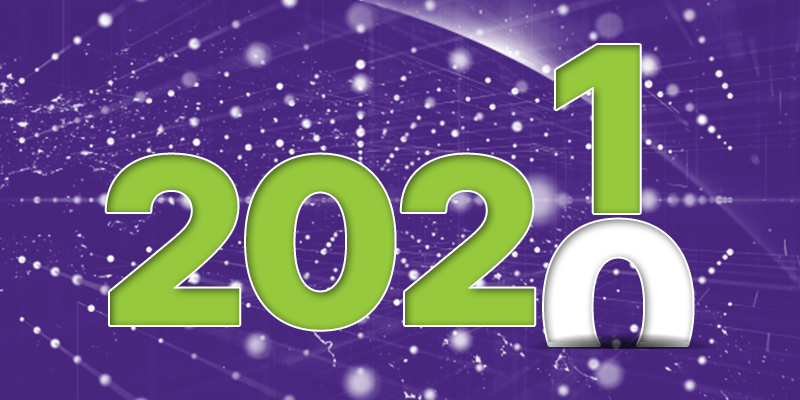Shining a light on the dark web
Discover how cybercriminals find their targets on the dark web:

For the average internet user, the dark web is something you only hear about in news broadcasts talking about the latest cyberattacks. But while you won’t find yourself in the dark web by accident, it’s important to know what it is and how you can protect yourself from it. Afterall, the dark web is where most cybercrimes get their start.
The dark web explained
In short, the dark web is a sort of online club where only the members know the ever-changing location.
Once a criminal learns the location, they anonymously gain access to sell stolen information and buy illicit items like illegally obtained credit cards.
Innovations in the dark web
The dark web isn’t just a marketplace, though. It’s also a gathering area where criminals can recruit each other to help with their next attack.
In fact, the rising rates of malware and computer viruses can partially be explained by cyber criminals coming together to pool their talent. They’ve created a new model for cybercrime where criminal specialists sell their talents to the highest bidder. Criminals might even loan out new technology with the promise that they get a portion of any stolen funds.
Protecting yourself and your family
The first step in protecting yourself from criminals in the dark web is to have a plan. The right cybersecurity tools will keep your important financial documents and your most precious memories safe from attack – or even accidental deletion.
And while cybercriminals are developing new methods and tools, cybersecurity professionals are innovating as well. Strategies for cyber resilience combine the best antivirus protection with state-of-the-art cloud backup services, so you’re protected while also prepared for the worst.
Ready to take the first step in protecting you and your family from the dark web?
Ransom hits main street
Cybercriminals have made headlines by forcing Fortune 500 companies to pay million-dollar ransom payments to retrieve their data and unlock their systems. But despite the headlines, most ransomware targets families as well as small and medium sized businesses.
In fact, the average ransom payment is closer to $50,000. And it makes sense – just like it is for common criminals, it’s easier to steal a purse than it is to rob millions from a bank.

Targeted by ransomware
Ransomware uses modern technology and cutting-edge tools to do something that feels decidedly old fashioned – steal from you. It’s a modern day grift, where criminals take something that you value and will only give it back in exchange for money
In the modern age, it looks like this: cybercriminals break into your device and lock away your most valuable files. They want to disrupt your life and your business so much that you’re willing to pay the cybercriminals to give back your most important files.
Ransomware tactics
“Their goal is disruption. How can your business operate if all the computers are locked up?” explains Grayson Milbourne, security intelligence director for Carbonite + Webroot. And businesses aren’t the only target.
Families might lose access to years of photos and videos because of a ransomware attack. That’s because criminals know that families are willing to pay to keep years’ worth of precious memories.
Of course, cybercriminals have added a new layer to their crimes. Now, instead of destroying your files if you don’t pay them, they’ll sell your files on the dark web. This way victims are even more likely to pay because they could lose passwords, business data and personal information.
How to fight back.
Cybercriminals aren’t the only ones using new technology, though. Cybersecurity experts are developing new tools for keeping cybercriminals out of your business and personal life. Of course, the first step to protecting you or your business is adopting a cybersecurity tool that protects your files and makes backups in case of emergency.
With safeguards in place, you won’t have to pick between losing your files and your privacy or paying cybercriminals.
Ready to take the first in protecting your most precious memories and most important documents?
3 reasons even Chromebook™ devices benefit from added security
Google Chromebook™ devices could rightly be called a game-changer for education. These low-cost laptops are within financial reach for far more families than their more expensive competitors, a fact that proved crucial with the outbreak of the COVID-19 pandemic at the beginning of last year.
During that period, Google donated more than 4,000 Chromebook devices to California schools and the sale of the devices surged, outselling Macs for the first time. They made remote learning possible for thousands of students who otherwise could have been quarantined without connections to the classroom. According to Google, 40 million students and educators were using Chromebook computers for learning as of last year.
Momentum is unlikely to slow anytime soon, especially since the Chrome operating system will now be the first many students are exposed to. The respected technology blog TechRadar has even referred to 2021 as “the year of the Chromebook.”
As a cybersecurity company, we naturally wonder what widespread use of Chromebook devices means for the online security of the general public. The good news is Chromebook security is pretty good compared to other devices and operating systems. Some interesting features like frequent sandboxing, automatic updates and “verified boot” go a long way to improve Chromebook security.
But the fact is, even Chromebook computers benefit from supplemental security. Here are a few of the reasons why.
- Users, especially new ones, make mistakes
There are several common user errors that put users, their personal information and their devices at risk. Many third-party security solutions are designed to account for exactly this type of behavior. Even strong security can’t prevent an account from being hacked if account credentials are stolen in a phishing attack, one of the most common causes of identity theft.
In 2020, phishing scams spiked by 510 percent between January and February alone. Scammers used the beginning of the pandemic to spoof sites like eBay, where in-demand goods were being bought and sold. In March, as lockdown went into full effect, attackers began targeting users of YouTube, HBO and Netflix at unprecedented rates.
In short, phishing scammers use current events to target vulnerable users, like those who are inexperienced, compulsive or still developing critical thinking skills – traits that apply to many school-aged children.
To combat phishing scams, it helps to have filters that can proactively alert users if there’s a high chance that a form field or website is likely to steal credentials. Security companies can do this by determining the likelihood a site isn’t what it seems based on its connection to other dishonest sites. This information, known as threat intelligence, can help proactively warn when a user may be headed for danger.
2. Fake apps are still cause for concern
There are plenty of examples of bad apps and sketchy Chrome extensions being downloaded from the Google Play Store. They vary in their seriousness from annoying, like constantly pushing ads to young users, to serious, like serving banking Trojans that target users’ personal financial information.
The Chromebook sandboxing feature will defend against many of these so-called “malicious apps” from invading devices through things like popular mobile games, but some will likely find ways to avoid the feature.
In the same way that threat intelligence can help proactively determine if a site is likely to be a vehicle for phishing attacks, it can also help determine if an app is likely to be malware disguised as an app based on how closely its related to other malware on the web.
3. Web-borne malware remains widespread
The internet is littered with unsafe websites that host viruses, malware, ransomware and other online threats. Some can slip spyware – malware that tracks a user’s online movements – onto devices without a user, especially an inexperienced internet user, noticing.
The Chromebook verified boot feature can help to disable these threats – if a user knows they’ve got one on their device. But many types of malware aren’t immediately obvious. They can operate in the background, perhaps collecting data on user’s habits or logging their keystrokes to try to steal passwords or other sensitive information.
Here again, warning users of threats in advance can make the difference between addressing an infection and avoiding one altogether. By providing advanced warning of a risky website or a suspect browser extension, a good antivirus solution can stop an infection before it happens. Think of it like maintaining a healthy immune system through diet and exercise to keep from coming down from the common cold.
Protecting vulnerable users from internet threats
It’s hard to be too cautious on the web, especially with users who are just starting to use it to study, learn and explore. There are security gaps in any operating system, so it helps to layer defenses against multiple types of threat.
When facing dangers like identity theft and spyware disguised as an addicting mobile game, it helps to have a little insider information on the “bad neighborhoods” of the internet.
Even with great device security, that’s the helpful information Chromebook users miss out on without installing a strong third-party antivirus solution.
Resilience lies with security: Securing remote access for your business
Remote access has helped us become more interconnected than ever before. In the United States alone, two months into the pandemic, approximately 35% of the workforce was teleworking. The growth of remote access allowed individuals to work with organizations and teams they don’t physically see or meet.
However, the demand for remote access has critical implications for security. Businesses now more than ever are expected to strike a balance between providing reliable remote access and properly securing it. Striking this balance also gives businesses the opportunity to retain customer loyalty and maintain a positive brand reputation. According to one study by Accenture, over 60% of consumers switched some or all of their business from one brand to another within the span of a year. Needless to say, securing remote access has major implications for business productivity and customer retention.
What is secure remote access?
Simply put, secure remote access is the ability to provide reliable entry into a user’s computer from a remote location outside of their work-related office. The user can access their company’s files and documents as if they were physically present at their office. Securing remote access can take different forms. The most popular options include virtual private network (VPN) or remote desktop protocol (RDP).
VPN works by initiating a secure connection over the internet through data encryption. Many businesses offer workers the opportunity to use this method by providing organizational connectivity through a VPN gateway to access the company’s internal network. One downside of using a VPN connection involves vulnerability. Any remote device that gains access to the VPN can share malware, for example, onto the internal company network.
RDP, on the other hand, functions by initiating a remote desktop connection option. Through the click of a mouse, a user can access their computer from any location by logging in with a username and password. However, activating this default feature opens the door to vulnerabilities. Through brute force, illegitimate actors can attempt to hack a user’s password by trying an infinite number of combinations. Without a lockout feature, cybercriminals can make repeated attempts. “This is where length of strength comes into play. It is important to have as many characters as possible within your password, so it’s harder for cybercriminals to crack,” says Tyler Moffitt, security analyst, Carbonite + Webroot, OpenText companies.
Overcoming obstacles
While the steps for securing remote access are simple, the learning curve for adoption may not be. Users, depending on their experience, may feel reluctant to learn another process. However, education is critical to maintaining a business’ security posture, especially when it comes to ransomware.
“The most common way we see ransomware affecting organizations – government municipalities, healthcare and education institutions – is through a breach. Once a cybercriminal is remoted onto a computer, it’s game over as far as security is concerned,” added Moffitt.
Benefits
The primary benefit of securing remote access is the ability to connect, work and engage from anywhere. A secure connection offers users the chance to work in locations previously not possible.
“The workplace will never be the same post-COVID. As more clients continue to maintain flexible working arrangements, it becomes even more important to secure clients remotely,” says Emma Furtado, customer advocacy manager, Carbonite + Webroot.
Adopting secure remote access also supports the maintenance of client satisfaction, overcoming reluctance and building brand advocacy.
“Carbonite + Webroot Luminaries, a group of managed service providers (MSPs), rely on their clients’ cyber resilience – and trust – to grow their businesses. After implementing Webroot products, many of their clients are open to multiple forms of secure remote access, such as VPN,” Furtado added.
Advice for organizational adoption
- Test, test, test. Like many applications, ongoing maintenance is key. Conducting frequent connection and penetration testing is important to ensure constant viability for users.
- Two-factor authentication. Whether it’s via email or text message, this additional security layer should be embedded within an organization’s remote access protocols.
- Document your procedures. Develop a standardized policy across your organization to ensure users understand the expectations surrounding remote access. This helps to build security awareness among users, which lessens the likelihood they will adopt shadow IT.
Embracing remote work with reliability and safety in mind
Securing remote access allows businesses to save money, reduce pressure on internal teams and protect intellectual property. As part of a robust cyber resilience strategy, businesses should prioritize developing the necessary backup, training, protection and restoration elements that will help maintain business continuity and enhance customer loyalty and trust.
To start your free Webroot® Security Awareness Training, please click here.
To learn more Webroot® Business Endpoint Protection, please click here.
NIST and No-notice: Finding the Goldilocks zone for phishing simulation difficulty
Earlier this year, the National Institute for Standards and Technology (NIST) published updated recommendations for phishing simulations in security awareness training programs. We discussed it on our Community page soon after the updated standards were released, but the substance of the change bears repeating.
“Practical exercises include no-notice social engineering attempts to collect information, gain unauthorized access, or simulate the adverse impact of opening malicious email attachments or invoking, via spear-phishing attacks, malicious web links.” – NIST SP 800-53, Rev. 5, Section 5.3 (pg. 60)
This update includes a recommendation for “no-notice” phishing simulations to be delivered at the beginning of security awareness training programs to more accurately gauge the readiness of a set of users to recognize a phishing attempt.
The thinking obviously being that letting users in on the phishing simulation game will heighten suspicion of their inbox and skew baseline results. This concern can be thought as a spin-off of the well-studied “Observer Effect” known in many scientific fields; observing the behavior of something necessarily changes that behavior.
While it might be tempting for a Chief Information Security Officer (CISO) or other IT professional to take high grades on a phishing simulation a sign of a job well done, that can be a dangerous conclusion to draw. Phishing tests that are too easy do little to address a problem that’s become one of the most common methods of entry for ransomware attacks.1 If IT professionals grade on a curve here, they’re doing very little to improve their organization’s overall cyber resilience.
Combatting this false sense of confidence about users’ ability to spot phishing attacks requires making sure simulations aren’t too easy to spot.
What makes a phishing simulation too easy?
After putting some thought into that question, NIST researchers published a paper last year in the Journal of Cybersecurity citing three key criteria for determining if a phishing simulation makes for good training.
According to the authors, “low click rates do not necessarily indicate training effectiveness and may instead mean the phishing emails” were:
- Too obvious – Either errors were too overt or these templates were running something akin to the Nigerian Prince scam. Either way, they won’t help an employee overcome today’s more sophisticated phishing attempts
- Not relevant to staff – We’re all busy at work. So deleting an email offering 25% off at Ed’s Golf Cart Repair Shop doesn’t mean a user is an expert at spotting scams. It just means there was nothing in the simulation that enticed anyone to click.
- The phish was repeated or similar to one that was – Phish me once, shame on me…but seriously, this drives home the importance of having a wide range of phishing templates. These programs work best when they’re ongoing, so it’s important to switch it up.
On the other hand, a phishing simulation is convincing if it does the following to some degree:
- Mimics a workplace process or practice
- Has workplace relevance
- Aligns with other situations or events, including those external to the workplace
- Presents consequences for NOT clicking (e.g., buy gift cards or we lose the client)
- References targeted training, specific warnings or other exposure
Tip: NIST has devised a weighted version of this scale, “the phish scale,” you can use to determine the difficulty of your simulations. A phishing simulation that has all of the above characteristics would be considered extremely difficult. That’s good, right?
Too much difficulty can be dangerous, too
Any security awareness training program that’s too difficult is liable to leave learners feeling put off, resigned to failure, or worse, coming away without any practical security learnings. This is especially true if users are punished too harshly for failing to spot a difficult phishing simulation.
Any program that’s both difficult and relying on a stick rather than a carrot for motivation runs the risk of:
- Reinforcing negative stereotypes of security training programs
- Encouraging employees to “game” the system by sharing information about tests
- Fostering animosity towards the organization’s overall security posture
- Inviting legal trouble from dissatisfied employees
For security awareness training to be successful, it has to be collaborative. Learners should feel like they’re part of something constructive, rather than just subjected to another type of performance review.
Hitting the sweet spot
Finding the appropriate difficulty level for phishing simulations is one of the reasons the initial, no-notice NIST recommendation is so important. It helps administrators establish baseline results that most accurately reflect users’ real understanding of phishing attacks. But we don’t recommend a training program be hidden from employees forever.
Instead, after initial results have been established, it’s better to announce the program publicly along with its goals, evaluation criteria and a point of contact for those interested in learning more. Once users are in the know, subsequent phishing simulations can focus on incremental improvements over the baseline results. As scores rise across the board, the difficulty can be gradually increased over time.
One essential recommendation: Always report publicly on positive results. Let users know they’re managing to catch more and more difficult simulations. Be as specific as possible, as in, “click-through rates dropped from A to B in this exercise.” This will help establish a sense of shared responsibility for organizational security and “gamify” the experience.
Calibrating your security awareness training is an ongoing experience. Don’t be afraid to adjust your simulations based on results. Happy learning.
Ready to establish your own successful security awareness training? Try us out free for 30 days.
1. Hiscox. “Cyber Readiness Report 2021.” (April 2021)
Survey: How well do IT pros know AI and machine learning?
What do the terms artificial intelligence and machine learning mean to you? If what comes to mind initially involves robot butlers or rogue computer programs, you’re not alone. Even IT pros at large enterprise organizations can’t escape pop culture visions fed by films and TV.
But today, as cyberattacks against businesses and individuals continue to proliferate, technologies like AI and ML that can drastically improve threat detection, protection and prevention are critical. This is even more true as workforces continue to operate remotely in such numbers.
That’s why, for a few years now, we’ve been conducting surveys of IT professionals to determine their familiarity with, and attitudes toward, artificial intelligence (AI) and machine learning (ML). For the purposes of this report, we surveyed IT decision-makers at enterprises (1000+ employees), small and medium-sized businesses (<250 employees), and consumers (home users) throughout the U.S., U.K., Japan, and Australia/New Zealand.
As a result, we learn about:
- Baseline cyber hygiene, including what cybersecurity tools are in use and how they’re used
- General experience with data breaches and attitudes toward the safety of their data
- How many organizations use cybersecurity tools with AI components
- Whether IT admins feel that AI actively contributes to the safety of their organizations or is marketing fluff
We titled this year’s survey Fact or Fiction: Perceptions and Misconceptions of AI and Machine Learning and expanded it to include professionals in the enterprise, mid-market organizations and private individuals. It’s one of the largest and most thorough reports on the topic we’ve put together to date and is packed with interesting findings.
Historically, we’ve seen significant confusion surrounding AI and ML. IT professionals are generally aware that they’re in-use, but struggle to voice how they’re helpful or what it is exactly that they do. In Australia, for instance, while the bulk of IT decision makers employ AI/ML-enabled solutions, barely over half (51%) are comfortable describing what they do.
Nevertheless, adoption of AI/ML-enabled technologies continues to rise. Today, more than 93% of enterprise-level businesses report using them. Overall, slightly less than half (47%) call increasing adoption of AI/ML their number one priority for addressing cybersecurity concerns in the coming year.
Here are a few other key takeaways regarding enterprise attitudes toward AI/ML:
- Understanding is growing – But more education is still required, so vendors must focus on benefits of AI/ML in terms of the bottom line and an enhanced security posture.
- AI/ML are key to repelling modern threats – Especially for remote workforces, advanced technologies are emerging as a key component for ensuring uptime and availability for clients.
- AI/ML can differentiate a business – Buyers are looking to invest in their tech stacks to stay out of the headlines for suffering a breach. As understanding of AI/ML grows, more are looking for these capabilities in their cyber defenses.
For the mid-market and individuals, another theme has persisted through our studies: overconfidence.
Among IT professionals at businesses with fewer than 250 employees, almost three-quarters (74%) of respondents believe their organizations are safe from most cyberattacks. But 48% have also admitted to falling victim to a data breach at least once. Interestingly, despite their confidence in their cybersecurity, the same respondents also believe their security situation has been worse by COVID-19.
Other notable findings among small and mid-sized businesses include:
- They’re beginning to recognize they’re targets – SMBs are catching onto the fact that cybercriminals pick off weak targets and realizing this fact’s implications for their supply chains.
- Limited IT budgets must be spent wisely – Without the resources to hire full-time IT staff, it becomes critical that a security stack defends against all the most common forms of attack (and their consequences).
- User education is key – If a business can’t spring for top-of-the-line cybersecurity solutions, educating users on how to keep from enabling breaches can go a long way towards building a strong defense with relatively little investment.

Consumers continue to report abysmal habits in their personal online lives. Less than half use an antivirus or other security tool. Only 16% report using a VPN when connecting in public spaces and 48% have had data stolen at least once. On the brighter side, constant headlines concerning corporations leaking consumer data have made consumers wary about who they give their data to and how much. This healthy skepticism is a good sign as the next large data breach is likely just around the corner.
Some valuable learning from the consumer sector, and how it bleeds over into the corporate sector, include:
- Business breaches affect consumers’ data – And they know it. Consumers are wary of providing too much sensitive data to companies after being barraged by news of high-profile hacks and data breaches.
- Consumers ARE NOT taking proper precautions – Fewer than half of home users have antivirus, backup or other cybersecurity measures in place. In all, 11% take no precautions online. This finding is especially relevant if remote workers are using personal devices for business.
- Unsurprisingly, AI/ML knowledge is lacking – When paid IT professionals don’t understand the technology, it may not be practical to expect the average consumer to be. But consumers should do their research on the tech powering their protection before committing to a VPN, antivirus or backup solution.
For the report’s complete findings, including a breakdown of cybersecurity spending by business size, download the full report.
The Rise of Ransomware
Ransomware attacks dominate news coverage of the cybersecurity industry. And it’s no wonder – with million-dollar payouts, infrastructure attacks and international manhunts, ransomware makes for exciting headlines. But its recent domination of the airwaves has been a long time coming.
“The first types of ransomware have existed for quite some time, going all the way back to the early 2000’s,” says Grayson Milbourne, security intelligence director at Carbonite + Webroot. Going through the history of ransomware, Grayson notes that it started as small time swindles “with the goal of getting you to pay 50 bucks.”
Evolving Threats
The ransomware we see today has evolved over the last 20 years to become the monster seen in news headlines. Instead of petty crooks, we now see criminal gangs that combine ransomware with worm-like capabilities that utilize a double extortion method.
In other words, “ransomware isn’t just a targeted model that you have to click on to fall for. Anybody can be attacked and breached,” explains Tyler Moffitt, senior threat analyst at Carbonite + Webroot.
The New Standard of Ransomware
Hackers not only steal and lock files away, they also leak data in the most damaging way if a ransom settlement is not reached. And the new brand of ransomware spreads through networks and across businesses so you might fall victim even though it was your colleague or business partner that clicked on the wrong link.
These new methods helped skyrocket the average ransom payment to almost $150,000. Even worse, most ransom payments end being around $50,000. The high average payment is buoyed by a few million-dollar ransoms, but most victims are small and medium businesses.
Fighting Back
Luckily, the news isn’t all bad. Yes, ransomware has had years to evolve into the juggernaut it is today. But analysts, security experts and threat researchers have also had time to craft new tools to keep people and businesses safe.
“It’s so much better modernizing your infrastructure up front in the appropriate defense in depth,” says Jon Murchison, CEO of Blackpoint Cyber. For Murchison, security efforts cannot wait until an attack happens, they need to be adopted in advance.
But the right tools, Murchison says “will save you from a bad day or an existential day to your business.”
Then stay tuned for Carbonite + Webroot’s episode 3 in our series on ransomware.
The 6 Nastiest Malware of 2021
Malware leaps from the darkness to envelop our lives in a cloak of stolen information, lost data and worse. But to know your enemy is to defeat your enemy. So we peered over the ledge leading to the dark web and leapt. The forces we sought are disruptors – without warning, they disturb our businesses and our connections to family and friends.
And darkness we found – from million-dollar ransoms to supply chain attacks, these malware variants were The 6 Nastiest Malware of 2021.
How malware disrupted our lives
These days, every major ransomware campaign runs a “double extortion” method, a scary prospect for small businesses. They steal and lock files away and they will absolutely leak data in the most damaging way if a ransom settlement is not reached.
Phishing continues to be key for these campaigns and it’s typically the first step in compromising a business for the nastiest malware.
This highlights the importance of user education – training users to avoid clicking these phishing lures or preventing them from enabling macros from these attachments are proven in stopping malware in its tracks.
While the list below may define payloads into different categories of malware, note that many of these bad actor groups contract work from others. This allows each group to specialize on their respective payload and perfect it.
This year’s wicked winners
Lemonduck
- A persisting botnet with a cryptomining payload and more
- Infects via emails, brute force, exploits and more
- Removes competing malware, ensuring they’re the only infection
REvil
- The Nastiest Ransomware of 2021 that made headlines with supply chain attacks
- Many attempts to shutdown the REvil group have so far failed
- Their ransomware as a service (RaaS) platform is on offer to other cybercriminals
Trickbot
- Decade old banking and info-stealing Trojan and backdoor
- Disables protections, spreads laterally and eventually leads to ransomware like Conti
- Extremely resilient, surviving numerous attacks over the years
Dridex
- Banking and info-stealing Trojan and backdoor
- Spreads laterally and listens for domain credentials
- Eventually leads to ransomware like Grief/BitPaymer/DoppelPaymer
Conti
- Longstanding ransomware group also known as Ryuk and likely linked to LockFile ransomware
- TrickBot’s favorite ransomware
- Will leak or auction off data if victims don’t pay the ransom
Cobalt Strike
- White hat-designed pen testing tool that’s been corrupted and used for evil
- Very powerful features like process injection, privilege escalation and credential harvesting
- The customizability and scalability are just too GOOD not to be abused by BAD actors
Victimized by malware
The good news (I guess) is that last year’s average ransom payment peaked at $200,000 and today’s average is just below $150,000.
The bad news is that hackers are spreading the love and targeting businesses of all sizes. In fact, most victims are small businesses that end up paying around $50,000. Ransomware actors are getting better with their tactics, recruiting talent and providing a streamlined user experience.
The whole process is terrifyingly simple and for every one that gets shut down, two spring up to replace it. To top it off, supply chain attacks are becoming a massive issue.
Protect yourself and your business
The key to staying safe is a layered approach to cybersecurity backed up by a cyber resilience strategy. Here are tips from our experts.
Strategies for business continuity
- Lock down Remote Desktop Protocols (RDP)
- Educate end users
- Install reputable cybersecurity software
- Set up a strong backup and disaster recovery plan
Strategies for individuals
- Develop a healthy dose of suspicion toward messages
- Protect devices with antivirus and data with a VPN
- Keep your antivirus software and other apps up to date
- Use a secure cloud backup
- Create strong, unique passwords (and don’t reuse them across accounts)
- If a download asks to enable macros, DON’T DO IT
Discover more about 2021’s Nastiest Malware on the Webroot Community.
What a difference a year makes, or does it?
2020 was a year of immense change. One thing is for certain – the world collectively witnessed the increase of digital interconnectivity. We began even more to rely on the internet as a conduit to the world. The rise of remote access to businesses, entertainment and interpersonal connections surged. The death of distance accelerated.
The increased reliance on remote access provided cybercriminals with an opportunity to exploit any easily accessible vulnerability. The rise in remote access, compounded by the need to learn more about the pandemic, offered an optimal climate for cybercriminals to thrive.
In 2021, the 24/7 news cycle was filled with stories of cyberattacks. There was the infrastructure ransomware attack on the Colonial Pipeline in May 2021, which caused the company to cease operations for days. Also the attack on JBS USA, which fell victim to ransomware and threatened U.S. food supplies. In another instance, a malicious actor was able to breach the Florida Water computer system and temporally alter the water content by changing the sodium hydroxide levels. In each of these examples, cybercriminals capitalized on the collective vulnerabilities of individuals and businesses to target critical infrastructure.
The list goes on.
In our 2020 Webroot Threat Report, our security experts made a series of predictions related to the threat landscape. Let’s revisit some of these predictions to see how close we came.
What small and medium-sized businesses (SMBs) encountered
Tyler Moffitt, security analyst at Carbonite + Webroot, OpenText companies, reinforced the likelihood that, “SMBs will continue to be targeted: they have lower budgets and scarce security staff, making them attractive targets.”
Over the course of the last year, “SMBs continued to be the prime target of ransomware authors. Although they have clearly attacked organizations of all sizes, small businesses do appear to be the most targeted,” says Moffitt.
Is the threat landscape more of the same?
Grayson Milbourne, security intelligence director at Carbonite + Webroot, predicted that in the coming year, “Expect to see more attacks against less-developed nations—not to generate revenue, but rather to disrupt and destroy.”
However, in the last 12 months, “We witnessed law enforcement fighting back at the infrastructure of ransomware operators, like Emotet, which was taken offline early in 2021. Cybercrime is no longer a punishment-free crime.”
Milbourne also remarked last year that, “Deepfakes are going to become a major threat. As the technology develops, anyone could make a fake video of someone else saying something they did not and could effectively weaponize it for malicious (or political) purposes.”
“One prime example that occurred this year involved an Australian news deepfake. The deepfake showcased a bogus discussion of an obscure cryptocurrency that helped to bolster financial gains for the currency. A very clever technique,” says Milbourne.
Infrastructure as a target
Matt Aldridge, lead solutions consultant at Carbonite + Webroot, forecasted, “All forms of the energy sector will continue to be at serious risk. In addition, service providers make very lucrative targets for attackers, as they are a single point of entry into many businesses. Executives will continue to be the targets of BEC attacks, which will continue to evolve in sophistication.”
Unfortunately, the Colonial Pipeline ransomware attack in particular bore this prediction out. “We’ve also seen cyberattacks facing the energy sectors in Slovakia, Norway, France, Puerto Rico and South Korea, among others. All forms of the energy sector will continue to be at serious risk,” says Aldridge.
Where do we go from here?
Our increasing reliance on information technology has provided a climate for malicious actors to take advantage. This underscores the importance of being fully prepared for when a cyberattack or natural disaster affects your business. Milbourne projects more software-based ransomware supply chain attacks. Ransomware, unfortunately, is only the beginning. Businesses that want to remain operational and secure need to modernize their information technology and security infrastructures. This helps to mitigate potential litigation and fines.
Moffitt adds, “With privacy regulations like GDPR and CCPA in full effect, we are likely to see ransomware threatening to leak important customer data to increase the likelihood that businesses will pay, even if they have adequate backups in place and don’t need the files back.”
With all this in mind, it is important to manage and protect your business. In the 2021 Webroot BrightCloud® Threat Report, we illustrate how securing and protecting your business doesn’t have to be overwhelming.
With the right combination of backup, training and protection, businesses can collectively create a comprehensive and integrated approach to tackle evolving threats. By adopting a cyber resilience posture, businesses small and large can mitigate risks in the ever-changing cyber threat landscape. This multi-layered approach not only bolsters your brand, but also increases customer loyalty and improves the customer experience. A definite win-win.
NIST’s ransomware guidelines look a lot like cyber resilience
When the Institute for Security & Technology’s Ransomware Task Force published its report on combatting ransomware this spring, the Colonial Pipeline, JBS meatpacking and Kaseya VSA attacks were still around the corner.
Nevertheless, the report took the danger presented by ransomware to both businesses and global security for granted. Already in 2020, according to the report:
- 2,4000 governmental agencies, healthcare facilities and schools had been hit with ransomware
- $350 million had been paid out ransomware actors, a 311% increase over 2019
- It was taking 287 days on average for a business to fully recover from a ransomware attack
Even given what we now know – that 2021 would feature some momentous ransomware attacks against physical and IT infrastructure – the report’s expert authors recognized the threat was dire. That led to them devising a “comprehensive framework for action, ”policy recommendations, in other words, for tackling the threat.
“The immediate physical and business risks posed by ransomware are compounded by the broader societal impact of the billions of dollars steered into criminal enterprises, funds that may be used for the proliferation of weapons of mass destruction, human trafficking, and other virulent global criminal activity.” -Ransomware Task Force, IST
While many of these would fall to law enforcement, U.S. and international governments to enact, the report makes for fascinating reading for anyone interested in ransomware. It also provides a number of helpful tips businesses of all sizes can enact to protect themselves against ransomware.
A key recommendation throughout is that business’ anti-ransomware policies “should be consistent with existing cybersecurity frameworks,” like those released by NIST, “but specific to ransomware.”
Luckily, it wouldn’t be long before NIST would publish its ransomware-specific recommendations for businesses. It just so happens, their recommendations look a lot like our cyber resilience framework.
Meeting NIST benchmarks
Earlier this summer, NIST released updated tips and tactics for dealing with ransomware.
The recommendations are split between actions users can take avoid infection and those businesses can take to quickly recover in case their compromised. This dual-focus approach to prevention and recovery aligns neatly with cyber resilience best practices (and similar thinking influenced our product roadmap).
On the preventative side, NIST advises:
- Using antivirus software at all times
- Keeping computers fully patched with security updates
- Using security products or services that block access to known ransomware sites on the internet
- Configuring operating systems or using software allowing only authorized applications to run
- Restricting or prohibiting the use of personal devices for work
It’s worth noting that blocking access to known ransomware sites is a recommendation that can be accomplished with network-level security. When paired with the strong recommendation to use antivirus software at all times, NIST’s recommended prevention measures already cover two key areas of focus in a cyber resilience strategy: endpoint security and network protection.
On the recovery side, NIST urges the following:
- Develop and implement an incident recovery plan with defined roles and strategies
- Carefully plan, implement and test a data backup and restoration strategy
- Maintain an up-to-date list of internal and external contacts for ransomware attacks, including law enforcement
Another core aspect of cyber resilience is the ability to recover data and return to business in the event of an attack. While natural disasters and unplanned outages were once the focus of these contingency plans, ransomware’s current popularity is another reason to ensure backup and recovery are accounted for.
NIST notes the importance of making sure backups are isolated from one another to prevent infections from spreading between them. For more information on configuring backups and meeting NIST’s other backup guidelines, check out our guide to disaster preparation, recovery and remediation.
Don’t overlook security awareness training
One aspect of ransomware prevention not mentioned by NIST is the importance of security awareness training. The RTF report cites a lack of understanding among business leaders as a contributing factor to its success and recommends increasing knowledge of the problem as a recommended objective.
But, perhaps because it’s seen primarily as a phishing-related problem as opposed to a ransomware-related one, NIST’s tips do not mention user education. We recommend this be added as a key component of a comprehensive ransomware protection plan – or any cyber resilience strategy, for that matter.
In a report by insurance firm Hiscox, phishing was by far the number one method of infiltration in ransomware attacks. Our data show that regular, ongoing training can help cut phishing by up to 72%. To tackle the root cause of ransomware infections, security awareness training should be considered an essential element of a cyber resilience strategy.
Supply chain attacks are closing in on MSPs
If you attended Black Hat this year, you couldn’t avoid the topic of supply chain attacks. From keynotes to vendor messaging to booth presentations, they were a ubiquitous topic in Las Vegas this year.
Supply chain attacks are cyberattacks targeting an upstream vendor for the ultimate purpose of compromising one or more of its customers. Cybercriminals are aware that, by compromising updates from trusted vendors, they can easily bypass installed security software to infect all customers that install it.
Essentially, compromising a software vendor allows damage to cascade down the supply chain to another supplier– a consequence sometimes known as the “waterfall effect” – to increase collateral damage against multiple targets.
Black Hat founder Jeff Moss even began this year’s conference with a few words about software supply chains.
“We all rely on the software supply chain,” he said. “We’re building tools and systems based on it. We’re trusting it. We’re hoping that people in the supply chain…are doing things to help everyone else in the supply chain. Because, if they don’t, everything we do is potentially vulnerable.”
“We all depend on the supply chain being fully immunized,” he continued, “and it’s not there yet.”
Now, “not there yet” is putting it mildly. A few recent, high-profile attacks bear recalling to demonstrate the scope of the problem.
SolarWinds
For many within cybersecurity, the SolarWinds attack by what are widely believed to be state-sponsored cybercriminals was the most significant supply chain attack since the Cleaner attack of 2018 and a worrying reminder of the damage made possible by the tactic.
SolarWinds is a Texas-based IT management platform that unknowingly pushed a Trojanized update to a large portion of its some 300,000 customers. It’s believed that the attackers concealed their presence within the victim’s network for some time to ensure they could carefully select their next targets and preserve time for intelligence gathering.
While not widely known at the time, it’s now assumed that this wide-net attack was ultimately an effort to compromise a handful of high-value intelligence and governmental agencies. Second-stage infections were then pushed against these targets, plus some of the world’s most influential technology vendors.
Critically, this type of espionage-inspired cyberattack differs a great deal from moneymaking practices embraced by for-profit hacking groups. These broadly targeted attacks against suppliers cause widespread disruption without obviously disrupting a specific target.
Codecov
Another supply chain attack targeted Codecov, a software development firm that makes tools for developers, in January 2021. Investigators told the newswire service Reuters that attackers were able to use the access they’d gained to breach hundreds of Codecove customers.
As was the case with SolarWinds, compromising Codecov may have presented access to other software vendors, which could have initiated the waterfall effect presented previously. The firm counts among its clients giants like IBM, Hewlett Packard and Atlassian.
The infosec researcher Matt Tait, who spoke at this year’s Black Hat on the topic of supply chain attacks, called the Codecov compromise an instance of high-volume disruption based on indiscriminate targeting.
According to the company, information stolen from customer devices was then sent to a third-party server outside of Codecov’s control, suggesting that espionage may have once again been the end-goal of the attackers.
Kaseya
Perhaps the most far-reaching supply chain attack conducted by a non-state actor in the history of the tactic took place this July. This time, Kaseya, one of the world’s largest IT management platforms, was compromised by the Russia-based hacking group REvil. Unlike in the SolarWinds and Codecov, this attack included a ransomware stage meant to deliver financial rather than intelligence returns for the attackers.
REvil targeted Kaseya’s remote monitoring and management (RMM) solution, known as Kaseya VSA, which is used to manage client machines from afar. Again, targeting was indiscriminate, but unlike with espionage actors, the ransomware gang could focus on maximizing financial returns of the attack rather than trying to avoid detection.
Describing the impact of this attack, the USC Berkeley infosec researcher Nicholas Weaver noted that, “Each victim is a small-to-medium-sized business that is going to, at best, find its computers unusable and, at worst, have all their data lost forever.”
In terms of the cascading effects of a supply chain attack, the Kaseya VSA compromise hit MSPs and their small business clients especially hard.
Protecting
Like a technology that advances through state-sponsored R&D but then becomes available to a wider public, recent supply chain attack techniques were honed by state-backed actors but have now been adopted by more run-of-the-mill ransomware actors. This is bad news for MSPs.
While agencies like the FBI and CISA have been warning for some time that MSPs are likely targets of advanced persistent threats (APTs), the Kaseya attack seems to have crossed a threshold. The problem is a significant security challenge, and one that some think only vendors can solve.
But there are a few measures MSPs can take to enhance their defenses against supply chain attacks. These include:
- Layer cybersecurity defenses for both you and your clients. Supply chain attacks commonly evade defenses by sneaking in with a trusted update. But after the initial compromise, network security can block communication with known-malicious IP addresses to limit damage.
- Mandating two-factor authentication (2FA) wherever possible. While 2FA isn’t the end of security issues, it makes things more difficult for cybercriminals at every turn.
- Monitor for anomalous web traffic. Be wary of communications with previously unknown IP addresses, unusual application traffic and other out-of-the-ordinary happenings on your network. Consider following these steps to reducing the time to detection of a compromise if one occurs.
- Push patches and updates with urgency. Zero-day vulnerabilities often play a key role in advancing the spread of supply chain infections. Closing those gaps as soon as possible is an actionable step MSPs can take to protect themselves and their clients.
- Back up everything. One of the most surefire ways of reducing the leverage an attacker has over you and your clients is keeping multiple backups of critical business data. Cybercriminals can’t be trusted to restore data even after a ransom is paid, so don’t be left relying on them.
- Test your backup plan. The day disaster strikes is not the time to discover if your disaster recovery plan is well designed. Instead, simulate a worst-case scenario ahead of time and see if any gaps emerge.
As global cybercrime collectives continue to experiment with supply chain attack techniques, we should expect more indiscriminate, wide-net infections to make headlines. To prevent passing these infections along to their clients, vendors must take the lead in security their products and processes. But MSPs aren’t helpless in protecting themselves and their clients.
It’s time to ask: Is ransomware insurance bad for cybersecurity?
The issue at the heart of ransomware insurance will be familiar to most parents of young children: rewarding bad behavior only invites more of the same, so it’s generally not a good idea. But critics of the ransomware insurance industry argue that’s exactly what the practice does.
Ransomware insurance has by now long been suspected of excusing lax security practices and inspiring confidence among cybercriminals that they’ll receive a timely payment following a successful breach.
Exactly how widespread ransomware claims by businesses are is difficult to determine since companies don’t exactly jump at the chance to discuss their run-ins with ransomware publicly. But it’s safe to assume that claims have risen alongside an undeniable surge in ransomware attacks.
Another issue with the cyber insurance industry stems from the fact that paying a ransom is no guarantee that data will be returned. In our recent report on the hidden costs of ransomware, nearly 20 percent of respondents were not able to recover their data even after making an extortion payment.
The Paris-based insurance giant AXA broke new ground this year by announcing it would stop insuring against cyberattacks, citing a lack of guidance from French regulators about the practice. It’s worth remembering that the FBI “does not support paying a ransom in response to a ransomware attack.”
So, if U.S.-based insurers were to follow AXA’s logic, they too would stop covering ransomware payments. So far, few have. For now.
Doomed to be a short-lived sector?
The industry publication InsuranceJournal.com recently wrote in a post on its site that “pressure is building on the industry to stop reimbursing for ransoms.” Before ransomware went rampant, the article notes, cybersecurity insurance was a profitable sub-category of the insurance business as a whole. But those days may be numbered. The sector is now “teetering on the edge of profitability” according to the post’s author.
It’s well-known within cybersecurity circles that ransomware actors will conduct advanced research to determine if a potential target is insured. If so, it’s hardly a deterrent since it increases the likelihood a payment will be made.
It winds up being a self-reinforcing cycle. As ProPublica wrote in its study of the industry, “by rewarding hackers, it encourages more ransomware attacks, which in turn frighten more businesses and government agencies into buying policies.”
A commonly cited defense of ransomware insurance is that they not only protect against the cost of the ransom, but also against knock-on expenses from ransomware like downtime, reallocation of tech resources and reputational damage. We know from our own research that these costs can be significant, so there’s some validity to this argument.
But the real question the cyber insurance industry needs to answer is whether it can ever again be profitable. A recently released paper from the British defense think tank Royal United Services Institute (RUSI), titled Cyber Insurance and the Cyber Security Challenge, identified this as one of the key challenges to the industry’s viability.
That paper found that “there is arguably too little global premium to absorb losses from a systemic event.” In other words, the next NotPetya could sink the industry.
Ransomware on the whole has caused losses in the cyber insurance industry, not least because, “unlike the majority of risks insurers cover, ransomware attacks are both a high-impact and a high-probability risk.”
Addressing cybersecurity insurance shortfalls
Importantly, the RUSI paper in the end reported that it was unable to find empirical evidence that “cyber insurers may be unintentionally facilitating the behavior of cybercriminals by contributing to the growth of targeted ransomware operations.” While that fact undermines arguments that cyber insurers are a boon for ransomware actors, it doesn’t speak to the question of viability.
As with any nascent industry, ransomware insurance vendors have some tough issues to grapple with concerning how they do business. The “race to the bottom,” which RUSI describes as a combination of cheap premiums and loose restrictions on underwriting (not requiring basic cybersecurity measures as part of the deal, for example), represents the real risk to the industry.
Its possible cyber insurance companies could drastically reduce claims by mandating a cyber resilience posture as a condition of being insured. Like a higher life insurance premium for a career stunt man, organizations without robust cybersecurity in place (including defense plus backup and restoration capabilities) could be forced to foot a higher bill. While this is already standard practice among many insurers, industry regulation may be required to prevent the opening of a market for insurers with more lax baseline cybersecurity requirements.
At the very least, insurers should insist on three core elements of cybersecurity strategy before underwriting:
- Endpoint and network level security to guard against attacks. Devices secured with antiviruses and networks secured by DNS filters or firewalls should be the bare minimum requirement for protecting against ransomware attacks. Without them, ransomware actors are being invited in the front door.
- Mandated ongoing security awareness training for employees. User-enabled breaches remain one of the most common causes of a successful ransomware attack. Without addressing end users’ tendency to fall for phishing and other social engineering attacks, while ransomware actors may find the front door locked, they know there’s a good chance it will be opened for them by someone on the inside.
- Proven data backup and security protocols. Maintaining complete copies of mission-critical data is one of the simplest ways to undermine ransomware actors. By collectively removing this key piece of leverage, organizations can go a long way toward normalizing the non-payment of ransomware demands, easing the burden on cyber insurers.
Making the above the minimum standard for organizations would both minimize the damage caused by ransomware actors and increase the viability of ransomware insurance as an industry. By prioritizing cyber resilience over any one category of security, businesses can prevent breaches and get back to work easier when they do occur.






